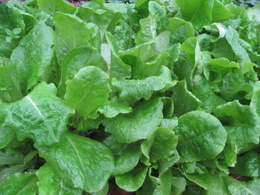Lettuce Growing Guide
Lettuce (Lactuca sativa) is a cool weather vegetable that you can plant as soon as the ground can be worked. There are many types to choose from. Popular varieties are the leaf type such as Black Seeded Simpson. In the small Butterhead category you can choose from Boston and Bibb. In the larger head variety Romaine and Iceberg are popular. Mesclun is a wonderful mixture of salad greens.
It can survive a pretty hard frost and can be harvested for your salad right up until Christmas in many areas, and even longer if you protect it with a row cover.
Soil Preparation
Lettuce likes a nice loose well-drained garden soil. Add compost and blend in before planting. Soil pH should be 6.2 to 6.8.
Planting Lettuce
The seeds can be direct sown 2 to 3-weeks before your last expected frost. Sow the seeds 1/8 to 1/4-inch deep covering with a fine cover of soil. Lettuce does best during the cool weather in the spring and fall. Some shade from other plants during hot weather will help keep it from bolting and going to seed.
Seeds can also be sown indoors in starting cells. After hardening off they can be transplanted into your garden.
For more detailed information visit the seed starting page.
Watering and Care
When the plants are a few inches tall add a nice loose mulch of shredded leaves or pine straw to shade the plant roots. This will keep the weeds out, the soil cooler and help retain moisture. Keep the mulch a couple of inches away from the stem. During dry spells give some water each week.
Harvesting Lettuce
Lettuce matures in about 45-days, but if you started your plants from seed you can start by thinning and removing any plants that are too close to others to give them more room to grow.
Many gardeners wait until the plant has matured and formed a head before removing the plant for their salad. Other gardeners start harvesting by removing leaves from the base of the plant stem, taking 2 or 3-leaves from the strongest plants. On young plants, be careful when removing leaves. You do not want to pull the plant out of the ground or disturb its roots. Use a sharp knife to cut 1 or 2 outer leaves at the base of each plant taking care not to injure the new leaves growing from the central crown.
After rinsing off the young tender leaves they can be added to a salad as greens. If you grew dill last year you will most likely be seeing it coming up all over your garden. Early in the growing season is the best time to remove it from the areas you do not want it and add it to your salad.
Allowing a small cluster of dill to grow will attract an egg laying Black Swallowtail female. Dill is one of the host plants for the caterpillar, which when feeding does not do any noticeable damage.
Established plants are very frost tolerant down to the low 20-degree range and will continue to grow. Depending on your growing zone you may be harvesting your lettuce up to and perhaps past Christmas. A light row cover can be used overnight to give some protection on the heavier frost nights.
Popular Varieties
Some popular varieties are: Black Seeded Simpson, Burpee Bibb, Simpson Elite, Mesclun Mix and Lollo Rossa.
Sources: Seeds Now, Burpee, Johnny's Selected Seeds
Diseases and Pests
Lettuce is usually trouble free, but occasionally in some areas downy mildew, mosaic, fusarium, aphids, leaf miners, cutworms and slugs may be a problem.
Garden Spikes newsletters give you timely information once or twice a month. Subscribe Free to the Garden Times newsletter below.
Your email address will only be used to send you a newsletter and will never be sold. You can unsubscribe at any time.

